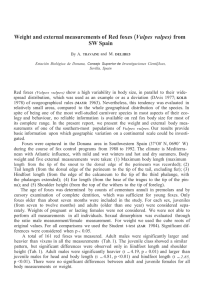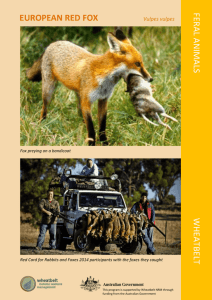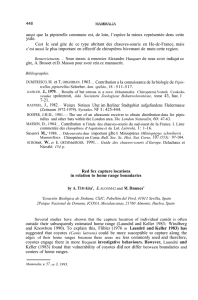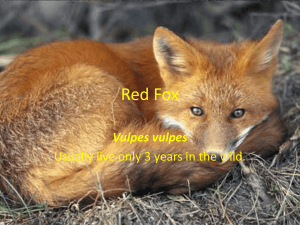servin et al 1991 acta theriolog.doc
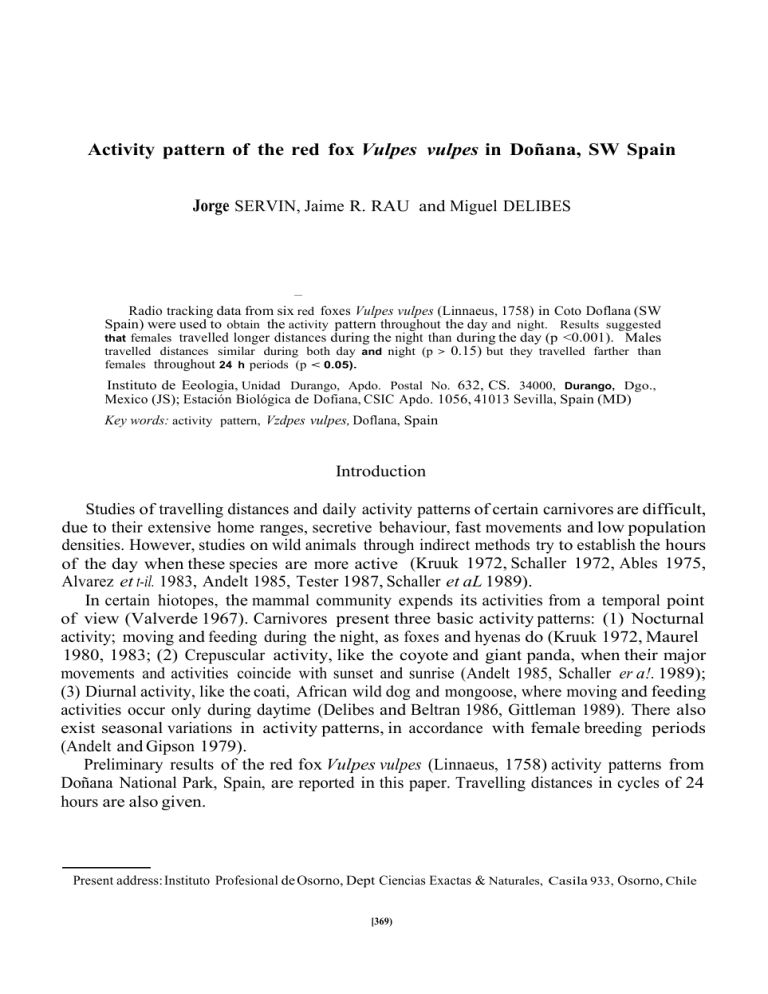
Activity pattern of the red fox Vulpes vulpes in Doñana, SW Spain
Jorge
SERVIN, Jaime R. RAU and Miguel DELIBES
—
Radio tracking data from six red foxes Vulpes vulpes (Linnaeus, 1758) in Coto Doflana (SW
Spain) were used to obtain the activity pattern throughout the day and night. Results suggested that females travelled longer distances during the night than during the day (p <0.001). Males travelled distances similar during both day and night (p > 0.15) but they travelled farther than females throughout 24 h periods (p < 0.05).
Instituto de Eeologia, Unidad Durango, Apdo. Postal No. 632, CS. 34000, Durango, Dgo.,
Mexico (JS); Estación Biológica de Dofiana, CSIC Apdo. 1056, 41013 Sevilla, Spain (MD)
Key words: activity pattern, Vzdpes vulpes, Doflana, Spain
Introduction
Studies of travelling distances and daily activity patterns of certain carnivores are difficult, due to their extensive home ranges, secretive behaviour, fast movements and low population densities. However, studies on wild animals through indirect methods try to establish the hours of the day when these species are more active (Kruuk 1972, Schaller 1972, Ables 1975,
Alvarez et t-il. 1983, Andelt 1985, Tester 1987, Schaller et aL 1989).
In certain hiotopes, the mammal community expends its activities from a temporal point of view (Valverde 1967). Carnivores present three basic activity patterns: (1) Nocturnal activity; moving and feeding during the night, as foxes and hyenas do (Kruuk 1972, Maurel
1980, 1983; (2) Crepuscular activity, like the coyote and giant panda, when their major movements and activities coincide with sunset and sunrise (Andelt 1985, Schaller er a!. 1989);
(3) Diurnal activity, like the coati, African wild dog and mongoose, where moving and feeding activities occur only during daytime (Delibes and Beltran 1986, Gittleman 1989). There also exist seasonal variations in activity patterns, in accordance with female breeding periods
(Andelt and Gipson 1979).
Preliminary results of the red fox Vulpes vulpes (Linnaeus, 1758) activity patterns from
Doñana National Park, Spain, are reported in this paper. Travelling distances in cycles of 24 hours are also given.
Present address: Instituto Profesional de Osorno, Dept Ciencias Exactas & Naturales, Casila 933, Osorno, Chile
[369)
3. Servin eta!.
Study area and methods
This research was conducted at the Dofiana National Park, in a Mediterranean shrub area, where a variety of dominant plants exists, for exampte: Haliniluni ha!im(fdium, H. ccrnmut at urn, Cistus libanotis, Erica scoparia and Ca!lunà vulgaris, among others (Allies et al. 1974). The weatherin this zone is Mediterranean-Atlantic with hot and dry summers, while winters are wet and cold (Allier et al. 1974, Delibes 1980). The fox movements were on the shrub area and on an ecotone between a floodable area or marisma and a wet zone of rush and grassland of Cynodon sp. and Paspalu,n sp.
Foxes were captured with snares, steel foothold traps (No. 2) and two door box traps similar to the
Tomatiaw& type Steel foothold traps were covered with soft material to avoid injuries when an animal was caught Traps were baited with synthetic urine (Cronck Co.), and a mix of chicken with fish was also used,
Two females and four males were captured and anesthetised with a mixture of ketamine and xylazine
(Delibes and Beltran 1986). Foxes were weighed and radiocollars (Biotrack) of the frequency 150
—
152 Mhz were attached. Males were radio- tracked from November 1984 to February 1985; and females from February to June 1985 (Fable 1).
Table I. Radiotraeking time, intensive 24 h periods, and number of làeations of six red foxes in Donana National Park, SW Spain.
Fox
Number
210
213
284
211*
112**
214
Sex Weight
(kg)
M
M
M
M
F
F
6.0
4.5
5.9
6.5
6.0
5.1
l)ate ol capture
Nov.84
Dec84 l)ee. 84
Jan.85
Jan.85
Feb.85
‘l’otal days monitored
73
72
31
159
142
Tracking
24 h
1
2
3
2
6
8
Number ol locations
59
91
97
44
225
250
*
Dead on February 18th, 1985.
**
Breeding female with pups (spring 1985).
Table 2. Mean distances (1cm) travelled by red foxes during day and night in Doliana National Park.
Females
Males
Average
Day Night 24h
1.35
4.58
5.93
4.45
5.37
9.82
2.90
4.97
7.88
N
14
8
22
Radiolocations of foxes were determined by compass bearings from 2 of 75 tracking stations. An “all terrain” vehicle was necessary in order to move faster from one station to the other, and thus enabled the triangulatinn method to be used (Meeh 1983). Radio signals were monitored with a receiver model LA-12
(AVM Instrument Co.), connected to a portable three element “yagi” antenna. For visual recognition of the animal, each collar was covered with a reflective plastic of different colors.
We assumed the distance travelled per hour was a measurement of activity, due to the fact that Canids are considered eursorial pursuers of prey. Hence we obtained distances travelled in a straightline between locations as an index of activity.
Activity of the red foxes 371
From 766 radiofixes accumulated during intensive 24 h radiotrabking periods with a one-hour interval, a
5° error was calculated from the bearing lectures (Table 1). The diurnal period is considered from 18:01 to
06:00 fi, while the nocturnal period is from 06:01 to 18:00 h, and the crepuscular time considered from 05:45 to 06:45 Ii (sunrise) and 17:45 to 18:45 h (sunset). Paired comparisons were made using the Student t-test in order to determine activity relationships between males and females, and also traveffing distances during night and thy. The p <0.05 calculation was required for the statistical significance (So&al and Rohlf 1981).
Results and discussion
The fox mean home range size was 116 ha, like in studies by Macdonald (1977), Maurel
(1980), Boitani ci at. (1984) and Blanco (1986). Foxes usually visit all boundary areas of their home range, and usually the pattern of movement is done in a rather erratic way.
Males Females
Fig. 1. Activity pattern of red fox (Vizipes vzdpes) in Donana, SW Spain; (0) females;
(•) males.
The female fox activity had its maximum mean of distance travelled of 0.55 km. between
00:00 and 01:00 hours; while minimum travelling distance of 0.05 km during daytime was between 12:00 and 13:00 hours (Pig. 1). Throughout all the nocturnal periods from 18:00 to
06:00 hours, females travelled, within their home range, a mean distance of 4.58 km, while during daytime, a mean distance of 1.35 km was travelled. Therefore, during the study time period females showed a nocturnal activity and were more active at night than on daytime
(t
=
7.78; d.f
=
23; p
<
0.001). The total mean of travelling distances of vixens was 5.93 km in the 24 hour cycles (Table 2).
Male foxes displayed both night and day activity, having maximum mean travelling distances during sunset between 18:00 and 19:00 hours
(?=
0.811cm; n
=
7) and sunrise from
372 3. Servin etal.
06:00 to 07:00 hours (1
=
0.59 1cm; n
=
5). They showed a crepuscular activity rhythm. At night foxes moved 5.37km, slightly more than during the daytime figure of 4.45 km. However, there were no significant differences between daytime and night movements (t
=
1.42; d.f.
=
23; p
>
0.15) (Table 2).
Comparing distances travelled by males and females in 24 hours, we found that male foxes had a mean travelling distance of 9.82 bit, and female foxes 5.93 km, the difference being significant (I
=
2.29; d.f.
=
21; p <0.05) (Table 2).
Total mean travelling distances for (he rcd fox in Donana National Park was 7.87 km in
24 hour cycles (n
=
22). The daytime mean distance covered was 2.90 1cm, while in the night foxes moved 4.97 1cm, suggesting that nocturnal movements were larger than diurnal ones
(:= 85.89; d.f.
=
23; p <0.001).
Conclusions
The results obtained suggest that activity patterns are influenced by enviromental and endogen factors. The interaction between these factors determine the animal’s movements in relation to time and within the home range.
The irregular pattern of activity in males can be explained by behavioral factors. In late winter there is the breeding period, and they need to move across their home range for scent marking, and defend it from competing intruders, as welt as searching for females and for food
(Macdonald 1977, Rau 1987).
Other aspect to be considered for explaining this pattern is food availability in winter, as foxes need to travel further distances to obtain their prey (Rau 1987). Females, on the other hand, spend more time around dens, getting prepared for gestation and pup rearing. This is why they travel smaller distances than males do (Macdonald 1977). The difference of activity patterns found in Doñana foxes and those from other places, could be explained by the actual protection of the study area and corresponding low human disturbance. Other studies carried out in the central region of Spain and Italy have indicated, that foxes show only nightly activity, because of human disturbance (Boitani er a!. 1984, Blanco 1986). However, in Doflana
National Park the females of the red fox showed a nocturnal activity pattern, while the males had a crepuscular activity pattern.
There is the need to continue our studies on adult foxes in order to determine the differences between males and females in daily and seasonal activity patterns in areas of varying human intervention.
Acknowledgements: We wish to thank Mr. R. Laffitte and I. P. Beltran ror their helpful labor during field work.
This research was funded by CSIC. Biological Station or Doulana, Spain. Instituto de Ecologla A.C., Mexico.
Dept Cieneias Exaetas. Inst. Pmfesional de Osorno, Chile. Two grants supported I. Servfn and 1. Rau from
Instituto de Cooperacidn Iberoatnericana. To M. Vences, A. Catalan and I. Mateos, for their encouragement. Two anonymous referees read and improved the manuscript. M. Huxley and L. Johnson helped in the English translation.
References
Ables E. D. 1975. Ecology of the red fox in North America. fIn: The Wild Canids; their systematics, behavioral ecology and evolution. M. W Pox, ed.]. Van Nostrand Reinhold, Amsterdam: 216
—
236.
Activity of the red foxes 373
Allier C., Gonzalez Bernaldez F. and Rasiiirez Diaz L. 1974. Mapa EcolOgico tie Ia Reserva Biologica de
Doilana. Division tie Ciencias del C.S.1.C., EstaciOn BiolOgica de Doflana, Sevilla.
Alvarez F., Azcarate T., Aguilera B. and Martin-Franquelo R. 1983. Clrcadian activity rhythms in a vertebrate community of Donana. Act. Congr. Tnt. Fauna Cineg. Silvestre. 15: 379 —387.
Andelt W. F. 1985. Behaviour ecology of coyotes in south Texas. WildI. Mouogr. 49: 1 —45.
Andelt W. F. and Gipson P. S. 1979. Home range, activity, and daily movements of coyotes. 1. WildI. Manage.
43: 944—951.
Blanco J. C. 1986. On the diet, size and use of home range and activity patterns of a red fox in central Spain.
Acta theriot. 31: 547
—
556.
Boitani L. Barraso P. and Grimod I. 1984. Ranging behaviour of the red fox in the Gran Paradiso National
Park (Italy). Boll. Zool. 51: 275
—284.
Delibes M. 1980. Et lince Ibérico, ecotogla y comportamiento alimenticios en el Coto Dohana, Huelva.
Dofmana, Ada Vertebrate 7 (esp.): I
—
128.
Delibes M. and Beltran I. F. 1985. Activity, daily movements and home range of an Ichneurnon or Egyptian
Mongoose ([Jerpestes ichnewnon) in southern Spain. I. Zonl., Lond. 207: 610— 613.
Gittleman I. L 1989. Carnivore group living: comparative trends. [In: Carnivore behaviour, ecology, and evolution. J. L. Gittleman, ed.1. Cornell University Press, New York: 183
—
207.
Kruuk H. 1971 The spotted hyena. University of Chicago Press, Chicago: I
—
335.
Maurel D. 1980. Home range and activity rhythm of adult male foxes during the breeding season. [In: A handbook on biotelemetry and radiotracking. C. I. Amlaner, Jr. and D. W. Macdonald, eds]. Pergamon
Press, Oxford: 697— 702.
Maurel D. 1983. Movements and space utilization in the fox (Vulpes yelper) as studied by radio-tracking in the forest of Chizb. Act Cong. Tnt. Fauna Cineg. Silvestre 15: 421 433.
Macdonald D. W. 1977. The behavioral ecology of the red fox. [In: Rabies the facts. C. Kaplan, ed.]. Oxford
University Press, Oxford: 70— 90.
Mech L D. 1983. Handbook of animal radio-tracking. University of Minnesota Press, Minneapolis: I 107.
—
Rau R. J. 1987. Ecologia del zorro, Vulpes vulpes (L.), en Ia Reserva BiolOgiea de Doflana, 3.0. de Espafla.
Tesis Doctoral. Univ. de Sevilla, Espana: 1 —258.
Sehailer G. 1972. The Serengeti lion. Chicago Univ.. Press, Chicago: 1 —480.
Schaller G., Jinchu H.. Wenshi P. and Jing Z. 1989. The giant pandas of Wolong. Chicago Univ. Press,
Chicago: 1
—298.
Sokal R. R. and Rohlf. F. J. 1969. Biometry. W.H. Freeman and Co., San Francisco, CaliL: 1
—
253.
Tester J. R. 1987. Changes in daily activity rhythms of some free-ranging animals in Minnesota. Can. Field
Nat. 101: 13—21.
Valverde J. A. 1967. Estructura de una comunidad de vertebrados terrestres. Monogr. list. Biot. Donana, 1:
1—219.
Received 19 October 1990, accepted 30 September1991.
Editors’ acknowledgement
During the 1991 calender year the following referees contributed to the review process by submitting comments on one or more manuscripts:
Boguslaw Bobek, Wieslaw Bogdanowicz, I. Lehr Brisbin, Jr., Gabriela B ujaiska, Jean Chaline, Norma
Chapmann, Andrzej DroM, Ryszard Dziçciolowski, Gilbert L. Dryden, L. L. Eberhard, K. Eiberle, Karl
Fredga, Bo Fry1estam Marek Gbczyñski, Joanna Gliwicz, Jacek Goszczydski, Stephen Harris, Günter
B. Harti, Heikki Henttonen, Miroslav Homolka, Zbigniew Jaczewski, Bogumila Jdrzejewska,
Wlodzimjerz Jcdrzejewski, Simona Kossak, Burt P. Kotler, Kazimierz Kowalski, Jan Kozlowski, Erik
Lindstrom, William Z. Lidicker, Chris Mason, W. 1. Montgomery, Adam Nadachowski, John Ozoga,
Marek Pawlikowski, Ewa Rajska-Jurgiel, KatarzynaSawicka-Kapusta, Jeremy B. Searle, Michal Sikorski,
Gerhard Storch, Peter Vogel, January Weiner, Don Wood, Jan M. Wdjclk, Piotr Wyrost, Maciej Zabel.
